Literature Review on Green Building: Drivers, Obstacles, and Benefits
VerifiedAdded on 2020/12/24
|16
|5493
|215
Literature Review
AI Summary
This dissertation presents a literature review on green building, exploring the evolving concept and its impact on the construction industry. The review begins by defining green building and its advantages, including reduced environmental impact, energy efficiency, and economic benefits like lo...
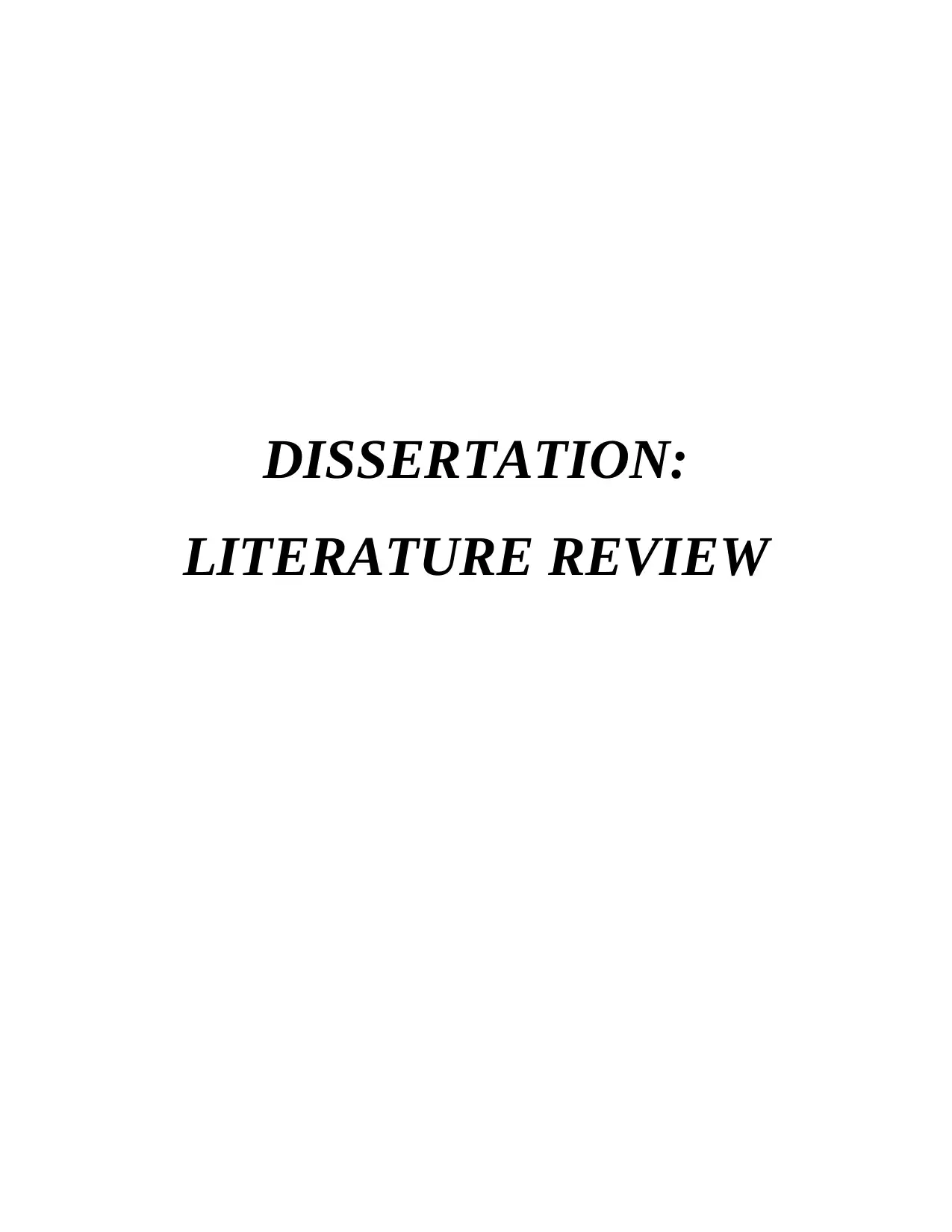
DISSERTATION:
LITERATURE REVIEW
LITERATURE REVIEW
Paraphrase This Document
Need a fresh take? Get an instant paraphrase of this document with our AI Paraphraser
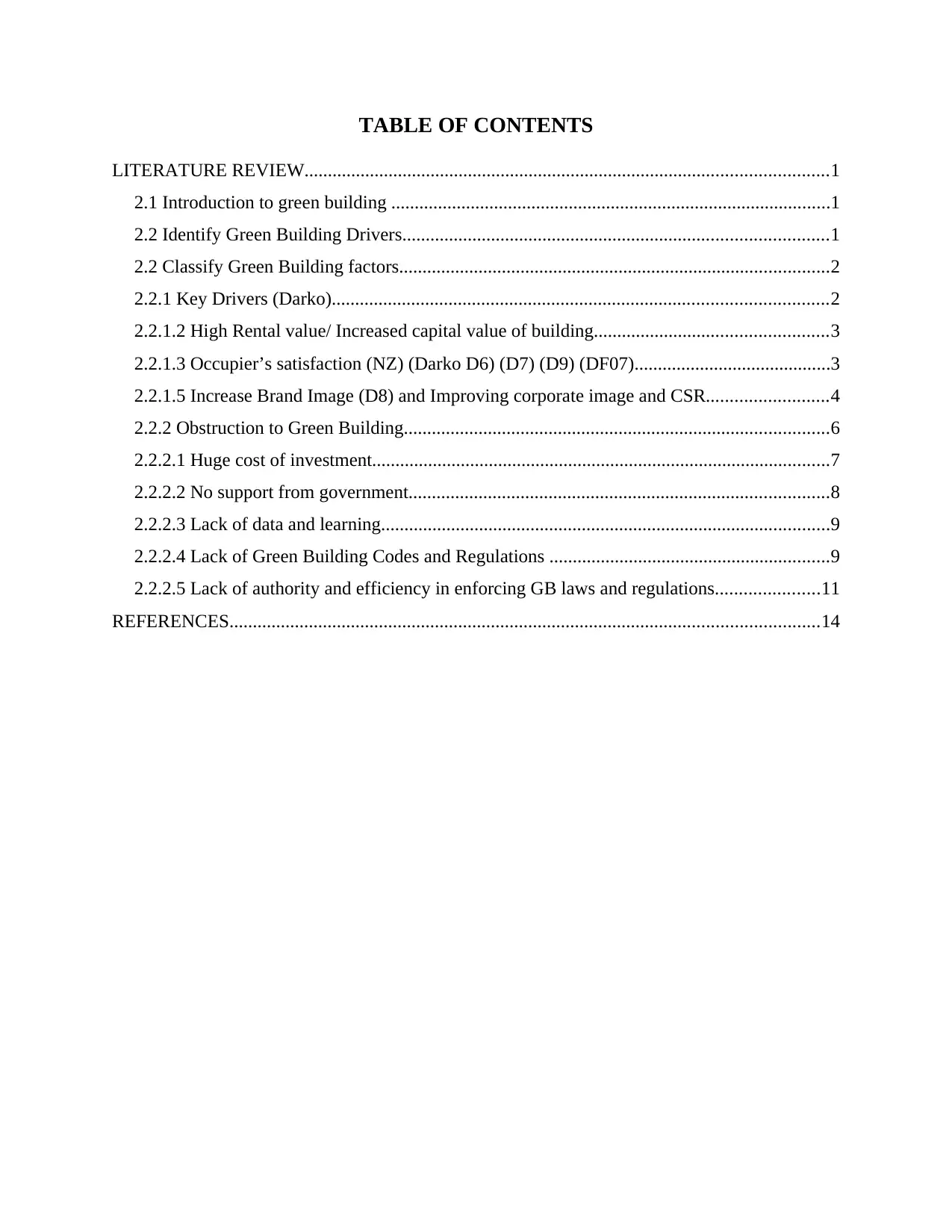
TABLE OF CONTENTS
LITERATURE REVIEW................................................................................................................1
2.1 Introduction to green building ..............................................................................................1
2.2 Identify Green Building Drivers...........................................................................................1
2.2 Classify Green Building factors............................................................................................2
2.2.1 Key Drivers (Darko)..........................................................................................................2
2.2.1.2 High Rental value/ Increased capital value of building..................................................3
2.2.1.3 Occupier’s satisfaction (NZ) (Darko D6) (D7) (D9) (DF07)..........................................3
2.2.1.5 Increase Brand Image (D8) and Improving corporate image and CSR..........................4
2.2.2 Obstruction to Green Building...........................................................................................6
2.2.2.1 Huge cost of investment..................................................................................................7
2.2.2.2 No support from government..........................................................................................8
2.2.2.3 Lack of data and learning................................................................................................9
2.2.2.4 Lack of Green Building Codes and Regulations ............................................................9
2.2.2.5 Lack of authority and efficiency in enforcing GB laws and regulations......................11
REFERENCES..............................................................................................................................14
LITERATURE REVIEW................................................................................................................1
2.1 Introduction to green building ..............................................................................................1
2.2 Identify Green Building Drivers...........................................................................................1
2.2 Classify Green Building factors............................................................................................2
2.2.1 Key Drivers (Darko)..........................................................................................................2
2.2.1.2 High Rental value/ Increased capital value of building..................................................3
2.2.1.3 Occupier’s satisfaction (NZ) (Darko D6) (D7) (D9) (DF07)..........................................3
2.2.1.5 Increase Brand Image (D8) and Improving corporate image and CSR..........................4
2.2.2 Obstruction to Green Building...........................................................................................6
2.2.2.1 Huge cost of investment..................................................................................................7
2.2.2.2 No support from government..........................................................................................8
2.2.2.3 Lack of data and learning................................................................................................9
2.2.2.4 Lack of Green Building Codes and Regulations ............................................................9
2.2.2.5 Lack of authority and efficiency in enforcing GB laws and regulations......................11
REFERENCES..............................................................................................................................14

LITERATURE REVIEW
2.1 Introduction to green building
In recent times green building is emerging trend that has changed the overall concept of
constructing houses. The world green building council 2018 defines it as concept that helps in
reducing negative impact on environment and creating a sustainable atmosphere in society.
There are several factors on which traditional and green buildings can be differentiated. These
are as follows:-
Effective utilisation of water, electricity, etc.
Using advanced technologies such as solar power, wind mill, etc.
Having features of recycling waste, reusing , etc.
A better quality of air.
An environment friendly design, materials used in interior design, etc.
There are various advantages that are provided by green buildings. It has been stated by
USGBC in report of 2018 that by constructing green buildings greenhouse gas (GHG) effects can
be reduced. Also, in a report of IPCC 2014, electricity used in building accounts for one fourth
(that is 25% ) of total emission of greenhouse gas in the world. In context of economic benefit,
green buildings use technology to generate electricity that leads to reduction in cost. As said by
Fowler and Rauch (2008), 26% energy can be reduced as compared to traditional building. Also,
by comparing maintenance cost it was found that it was 13% more in traditional building. At last
social benefit provided is it creates green and pollution free environment that helps in increasing
the lifestyle of people. (World Green Building Council, 2018)
2.2 Identify Green Building Drivers
The factors are reviewed in order to identify some barriers and drivers. In present
literature review Thailand and international barriers are taken into consideration. But in this only
barriers related to Thailand is explained. Moreover, it is having been identified that what benefits
1
2.1 Introduction to green building
In recent times green building is emerging trend that has changed the overall concept of
constructing houses. The world green building council 2018 defines it as concept that helps in
reducing negative impact on environment and creating a sustainable atmosphere in society.
There are several factors on which traditional and green buildings can be differentiated. These
are as follows:-
Effective utilisation of water, electricity, etc.
Using advanced technologies such as solar power, wind mill, etc.
Having features of recycling waste, reusing , etc.
A better quality of air.
An environment friendly design, materials used in interior design, etc.
There are various advantages that are provided by green buildings. It has been stated by
USGBC in report of 2018 that by constructing green buildings greenhouse gas (GHG) effects can
be reduced. Also, in a report of IPCC 2014, electricity used in building accounts for one fourth
(that is 25% ) of total emission of greenhouse gas in the world. In context of economic benefit,
green buildings use technology to generate electricity that leads to reduction in cost. As said by
Fowler and Rauch (2008), 26% energy can be reduced as compared to traditional building. Also,
by comparing maintenance cost it was found that it was 13% more in traditional building. At last
social benefit provided is it creates green and pollution free environment that helps in increasing
the lifestyle of people. (World Green Building Council, 2018)
2.2 Identify Green Building Drivers
The factors are reviewed in order to identify some barriers and drivers. In present
literature review Thailand and international barriers are taken into consideration. But in this only
barriers related to Thailand is explained. Moreover, it is having been identified that what benefits
1
⊘ This is a preview!⊘
Do you want full access?
Subscribe today to unlock all pages.

Trusted by 1+ million students worldwide
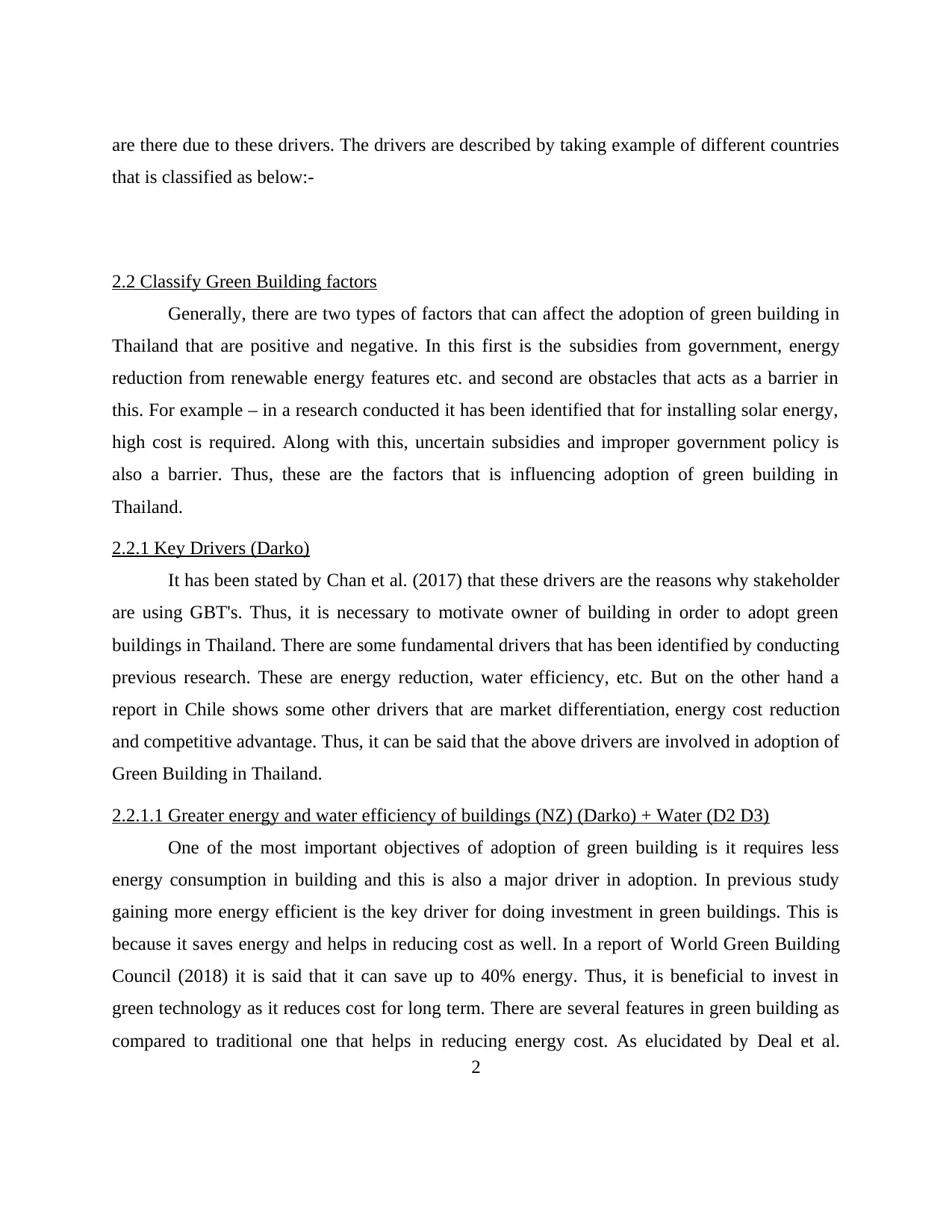
are there due to these drivers. The drivers are described by taking example of different countries
that is classified as below:-
2.2 Classify Green Building factors
Generally, there are two types of factors that can affect the adoption of green building in
Thailand that are positive and negative. In this first is the subsidies from government, energy
reduction from renewable energy features etc. and second are obstacles that acts as a barrier in
this. For example – in a research conducted it has been identified that for installing solar energy,
high cost is required. Along with this, uncertain subsidies and improper government policy is
also a barrier. Thus, these are the factors that is influencing adoption of green building in
Thailand.
2.2.1 Key Drivers (Darko)
It has been stated by Chan et al. (2017) that these drivers are the reasons why stakeholder
are using GBT's. Thus, it is necessary to motivate owner of building in order to adopt green
buildings in Thailand. There are some fundamental drivers that has been identified by conducting
previous research. These are energy reduction, water efficiency, etc. But on the other hand a
report in Chile shows some other drivers that are market differentiation, energy cost reduction
and competitive advantage. Thus, it can be said that the above drivers are involved in adoption of
Green Building in Thailand.
2.2.1.1 Greater energy and water efficiency of buildings (NZ) (Darko) + Water (D2 D3)
One of the most important objectives of adoption of green building is it requires less
energy consumption in building and this is also a major driver in adoption. In previous study
gaining more energy efficient is the key driver for doing investment in green buildings. This is
because it saves energy and helps in reducing cost as well. In a report of World Green Building
Council (2018) it is said that it can save up to 40% energy. Thus, it is beneficial to invest in
green technology as it reduces cost for long term. There are several features in green building as
compared to traditional one that helps in reducing energy cost. As elucidated by Deal et al.
2
that is classified as below:-
2.2 Classify Green Building factors
Generally, there are two types of factors that can affect the adoption of green building in
Thailand that are positive and negative. In this first is the subsidies from government, energy
reduction from renewable energy features etc. and second are obstacles that acts as a barrier in
this. For example – in a research conducted it has been identified that for installing solar energy,
high cost is required. Along with this, uncertain subsidies and improper government policy is
also a barrier. Thus, these are the factors that is influencing adoption of green building in
Thailand.
2.2.1 Key Drivers (Darko)
It has been stated by Chan et al. (2017) that these drivers are the reasons why stakeholder
are using GBT's. Thus, it is necessary to motivate owner of building in order to adopt green
buildings in Thailand. There are some fundamental drivers that has been identified by conducting
previous research. These are energy reduction, water efficiency, etc. But on the other hand a
report in Chile shows some other drivers that are market differentiation, energy cost reduction
and competitive advantage. Thus, it can be said that the above drivers are involved in adoption of
Green Building in Thailand.
2.2.1.1 Greater energy and water efficiency of buildings (NZ) (Darko) + Water (D2 D3)
One of the most important objectives of adoption of green building is it requires less
energy consumption in building and this is also a major driver in adoption. In previous study
gaining more energy efficient is the key driver for doing investment in green buildings. This is
because it saves energy and helps in reducing cost as well. In a report of World Green Building
Council (2018) it is said that it can save up to 40% energy. Thus, it is beneficial to invest in
green technology as it reduces cost for long term. There are several features in green building as
compared to traditional one that helps in reducing energy cost. As elucidated by Deal et al.
2
Paraphrase This Document
Need a fresh take? Get an instant paraphrase of this document with our AI Paraphraser
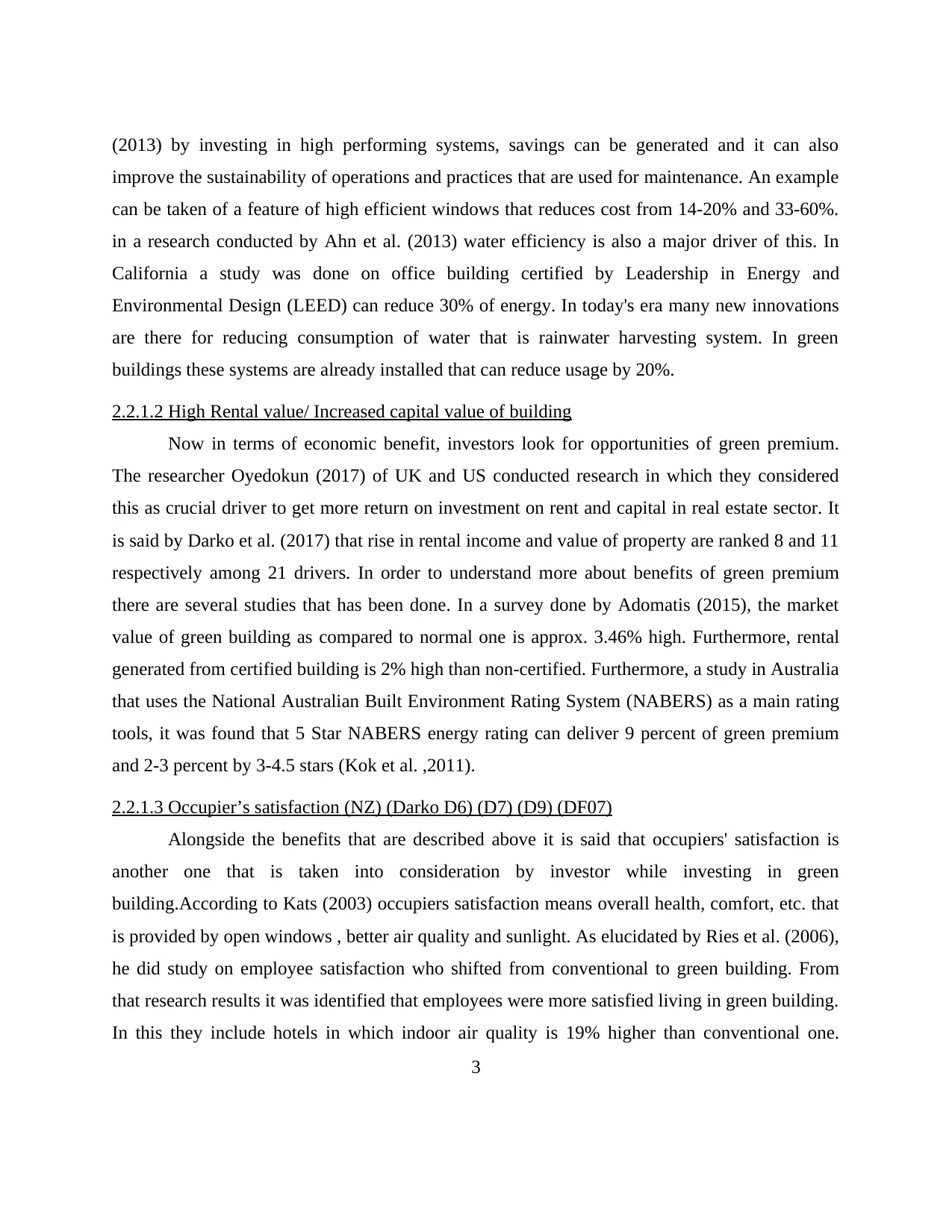
(2013) by investing in high performing systems, savings can be generated and it can also
improve the sustainability of operations and practices that are used for maintenance. An example
can be taken of a feature of high efficient windows that reduces cost from 14-20% and 33-60%.
in a research conducted by Ahn et al. (2013) water efficiency is also a major driver of this. In
California a study was done on office building certified by Leadership in Energy and
Environmental Design (LEED) can reduce 30% of energy. In today's era many new innovations
are there for reducing consumption of water that is rainwater harvesting system. In green
buildings these systems are already installed that can reduce usage by 20%.
2.2.1.2 High Rental value/ Increased capital value of building
Now in terms of economic benefit, investors look for opportunities of green premium.
The researcher Oyedokun (2017) of UK and US conducted research in which they considered
this as crucial driver to get more return on investment on rent and capital in real estate sector. It
is said by Darko et al. (2017) that rise in rental income and value of property are ranked 8 and 11
respectively among 21 drivers. In order to understand more about benefits of green premium
there are several studies that has been done. In a survey done by Adomatis (2015), the market
value of green building as compared to normal one is approx. 3.46% high. Furthermore, rental
generated from certified building is 2% high than non-certified. Furthermore, a study in Australia
that uses the National Australian Built Environment Rating System (NABERS) as a main rating
tools, it was found that 5 Star NABERS energy rating can deliver 9 percent of green premium
and 2-3 percent by 3-4.5 stars (Kok et al. ,2011).
2.2.1.3 Occupier’s satisfaction (NZ) (Darko D6) (D7) (D9) (DF07)
Alongside the benefits that are described above it is said that occupiers' satisfaction is
another one that is taken into consideration by investor while investing in green
building.According to Kats (2003) occupiers satisfaction means overall health, comfort, etc. that
is provided by open windows , better air quality and sunlight. As elucidated by Ries et al. (2006),
he did study on employee satisfaction who shifted from conventional to green building. From
that research results it was identified that employees were more satisfied living in green building.
In this they include hotels in which indoor air quality is 19% higher than conventional one.
3
improve the sustainability of operations and practices that are used for maintenance. An example
can be taken of a feature of high efficient windows that reduces cost from 14-20% and 33-60%.
in a research conducted by Ahn et al. (2013) water efficiency is also a major driver of this. In
California a study was done on office building certified by Leadership in Energy and
Environmental Design (LEED) can reduce 30% of energy. In today's era many new innovations
are there for reducing consumption of water that is rainwater harvesting system. In green
buildings these systems are already installed that can reduce usage by 20%.
2.2.1.2 High Rental value/ Increased capital value of building
Now in terms of economic benefit, investors look for opportunities of green premium.
The researcher Oyedokun (2017) of UK and US conducted research in which they considered
this as crucial driver to get more return on investment on rent and capital in real estate sector. It
is said by Darko et al. (2017) that rise in rental income and value of property are ranked 8 and 11
respectively among 21 drivers. In order to understand more about benefits of green premium
there are several studies that has been done. In a survey done by Adomatis (2015), the market
value of green building as compared to normal one is approx. 3.46% high. Furthermore, rental
generated from certified building is 2% high than non-certified. Furthermore, a study in Australia
that uses the National Australian Built Environment Rating System (NABERS) as a main rating
tools, it was found that 5 Star NABERS energy rating can deliver 9 percent of green premium
and 2-3 percent by 3-4.5 stars (Kok et al. ,2011).
2.2.1.3 Occupier’s satisfaction (NZ) (Darko D6) (D7) (D9) (DF07)
Alongside the benefits that are described above it is said that occupiers' satisfaction is
another one that is taken into consideration by investor while investing in green
building.According to Kats (2003) occupiers satisfaction means overall health, comfort, etc. that
is provided by open windows , better air quality and sunlight. As elucidated by Ries et al. (2006),
he did study on employee satisfaction who shifted from conventional to green building. From
that research results it was identified that employees were more satisfied living in green building.
In this they include hotels in which indoor air quality is 19% higher than conventional one.
3
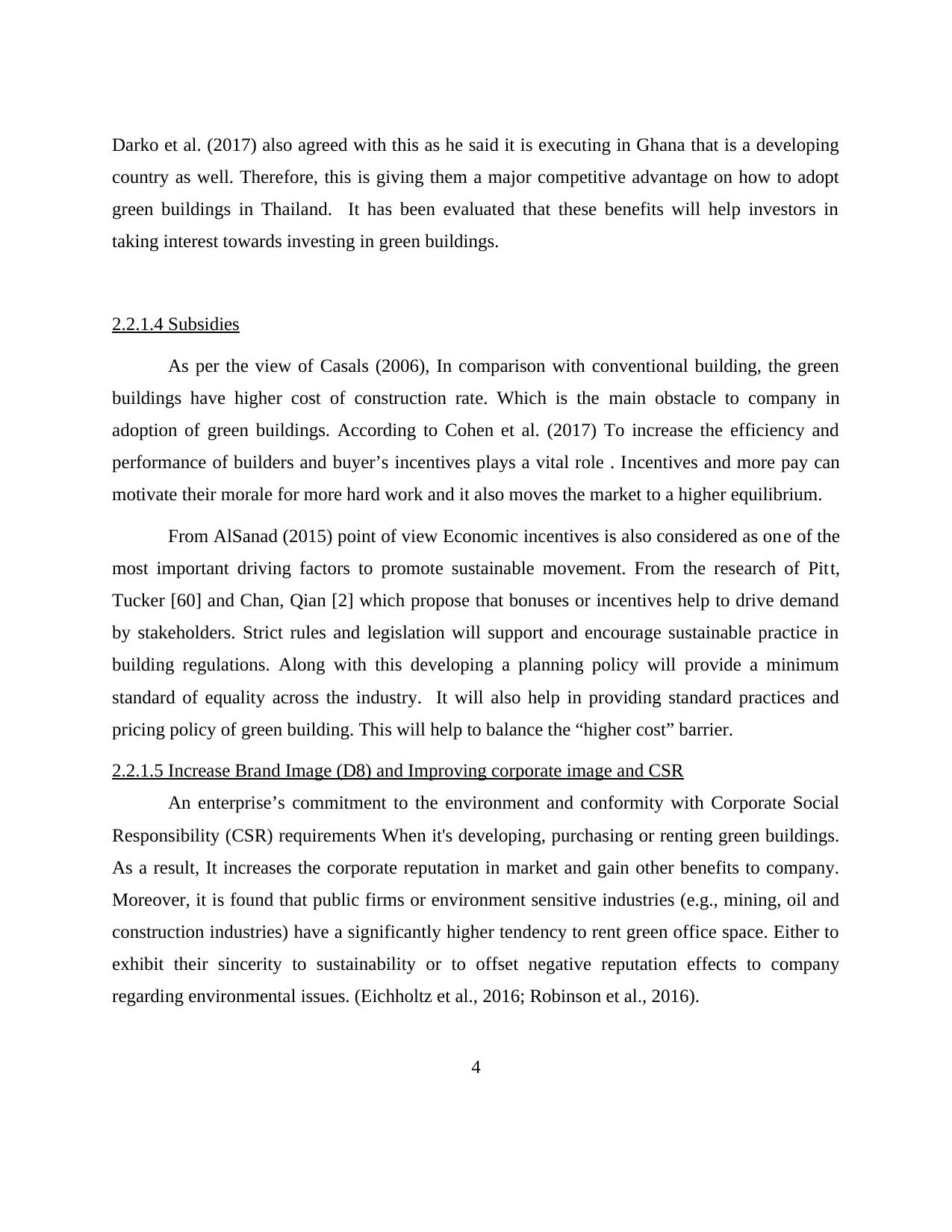
Darko et al. (2017) also agreed with this as he said it is executing in Ghana that is a developing
country as well. Therefore, this is giving them a major competitive advantage on how to adopt
green buildings in Thailand. It has been evaluated that these benefits will help investors in
taking interest towards investing in green buildings.
2.2.1.4 Subsidies
As per the view of Casals (2006), In comparison with conventional building, the green
buildings have higher cost of construction rate. Which is the main obstacle to company in
adoption of green buildings. According to Cohen et al. (2017) To increase the efficiency and
performance of builders and buyer’s incentives plays a vital role . Incentives and more pay can
motivate their morale for more hard work and it also moves the market to a higher equilibrium.
From AlSanad (2015) point of view Economic incentives is also considered as one of the
most important driving factors to promote sustainable movement. From the research of Pitt,
Tucker [60] and Chan, Qian [2] which propose that bonuses or incentives help to drive demand
by stakeholders. Strict rules and legislation will support and encourage sustainable practice in
building regulations. Along with this developing a planning policy will provide a minimum
standard of equality across the industry. It will also help in providing standard practices and
pricing policy of green building. This will help to balance the “higher cost” barrier.
2.2.1.5 Increase Brand Image (D8) and Improving corporate image and CSR
An enterprise’s commitment to the environment and conformity with Corporate Social
Responsibility (CSR) requirements When it's developing, purchasing or renting green buildings.
As a result, It increases the corporate reputation in market and gain other benefits to company.
Moreover, it is found that public firms or environment sensitive industries (e.g., mining, oil and
construction industries) have a significantly higher tendency to rent green office space. Either to
exhibit their sincerity to sustainability or to offset negative reputation effects to company
regarding environmental issues. (Eichholtz et al., 2016; Robinson et al., 2016).
4
country as well. Therefore, this is giving them a major competitive advantage on how to adopt
green buildings in Thailand. It has been evaluated that these benefits will help investors in
taking interest towards investing in green buildings.
2.2.1.4 Subsidies
As per the view of Casals (2006), In comparison with conventional building, the green
buildings have higher cost of construction rate. Which is the main obstacle to company in
adoption of green buildings. According to Cohen et al. (2017) To increase the efficiency and
performance of builders and buyer’s incentives plays a vital role . Incentives and more pay can
motivate their morale for more hard work and it also moves the market to a higher equilibrium.
From AlSanad (2015) point of view Economic incentives is also considered as one of the
most important driving factors to promote sustainable movement. From the research of Pitt,
Tucker [60] and Chan, Qian [2] which propose that bonuses or incentives help to drive demand
by stakeholders. Strict rules and legislation will support and encourage sustainable practice in
building regulations. Along with this developing a planning policy will provide a minimum
standard of equality across the industry. It will also help in providing standard practices and
pricing policy of green building. This will help to balance the “higher cost” barrier.
2.2.1.5 Increase Brand Image (D8) and Improving corporate image and CSR
An enterprise’s commitment to the environment and conformity with Corporate Social
Responsibility (CSR) requirements When it's developing, purchasing or renting green buildings.
As a result, It increases the corporate reputation in market and gain other benefits to company.
Moreover, it is found that public firms or environment sensitive industries (e.g., mining, oil and
construction industries) have a significantly higher tendency to rent green office space. Either to
exhibit their sincerity to sustainability or to offset negative reputation effects to company
regarding environmental issues. (Eichholtz et al., 2016; Robinson et al., 2016).
4
⊘ This is a preview!⊘
Do you want full access?
Subscribe today to unlock all pages.

Trusted by 1+ million students worldwide
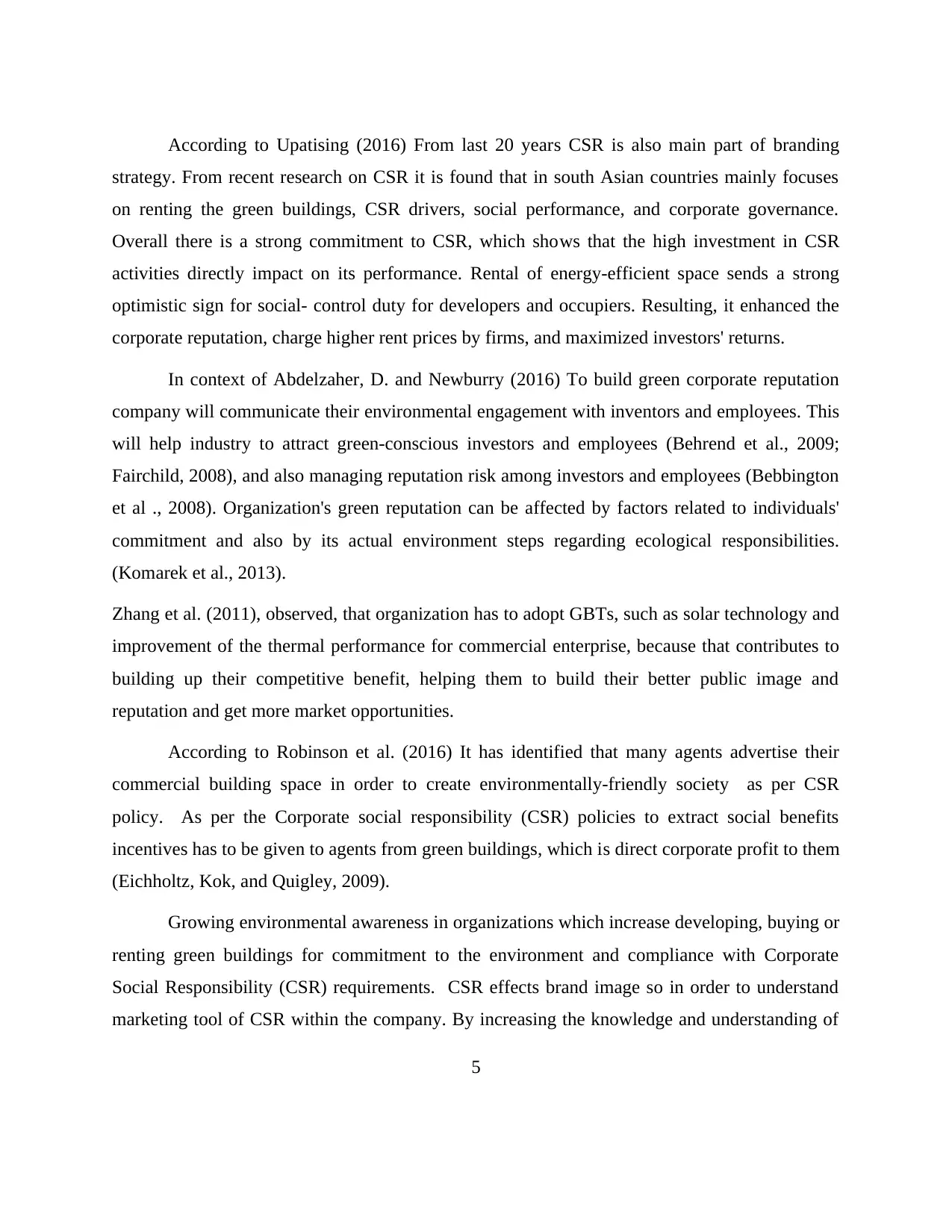
According to Upatising (2016) From last 20 years CSR is also main part of branding
strategy. From recent research on CSR it is found that in south Asian countries mainly focuses
on renting the green buildings, CSR drivers, social performance, and corporate governance.
Overall there is a strong commitment to CSR, which shows that the high investment in CSR
activities directly impact on its performance. Rental of energy-efficient space sends a strong
optimistic sign for social- control duty for developers and occupiers. Resulting, it enhanced the
corporate reputation, charge higher rent prices by firms, and maximized investors' returns.
In context of Abdelzaher, D. and Newburry (2016) To build green corporate reputation
company will communicate their environmental engagement with inventors and employees. This
will help industry to attract green-conscious investors and employees (Behrend et al., 2009;
Fairchild, 2008), and also managing reputation risk among investors and employees (Bebbington
et al ., 2008). Organization's green reputation can be affected by factors related to individuals'
commitment and also by its actual environment steps regarding ecological responsibilities.
(Komarek et al., 2013).
Zhang et al. (2011), observed, that organization has to adopt GBTs, such as solar technology and
improvement of the thermal performance for commercial enterprise, because that contributes to
building up their competitive benefit, helping them to build their better public image and
reputation and get more market opportunities.
According to Robinson et al. (2016) It has identified that many agents advertise their
commercial building space in order to create environmentally-friendly society as per CSR
policy. As per the Corporate social responsibility (CSR) policies to extract social benefits
incentives has to be given to agents from green buildings, which is direct corporate profit to them
(Eichholtz, Kok, and Quigley, 2009).
Growing environmental awareness in organizations which increase developing, buying or
renting green buildings for commitment to the environment and compliance with Corporate
Social Responsibility (CSR) requirements. CSR effects brand image so in order to understand
marketing tool of CSR within the company. By increasing the knowledge and understanding of
5
strategy. From recent research on CSR it is found that in south Asian countries mainly focuses
on renting the green buildings, CSR drivers, social performance, and corporate governance.
Overall there is a strong commitment to CSR, which shows that the high investment in CSR
activities directly impact on its performance. Rental of energy-efficient space sends a strong
optimistic sign for social- control duty for developers and occupiers. Resulting, it enhanced the
corporate reputation, charge higher rent prices by firms, and maximized investors' returns.
In context of Abdelzaher, D. and Newburry (2016) To build green corporate reputation
company will communicate their environmental engagement with inventors and employees. This
will help industry to attract green-conscious investors and employees (Behrend et al., 2009;
Fairchild, 2008), and also managing reputation risk among investors and employees (Bebbington
et al ., 2008). Organization's green reputation can be affected by factors related to individuals'
commitment and also by its actual environment steps regarding ecological responsibilities.
(Komarek et al., 2013).
Zhang et al. (2011), observed, that organization has to adopt GBTs, such as solar technology and
improvement of the thermal performance for commercial enterprise, because that contributes to
building up their competitive benefit, helping them to build their better public image and
reputation and get more market opportunities.
According to Robinson et al. (2016) It has identified that many agents advertise their
commercial building space in order to create environmentally-friendly society as per CSR
policy. As per the Corporate social responsibility (CSR) policies to extract social benefits
incentives has to be given to agents from green buildings, which is direct corporate profit to them
(Eichholtz, Kok, and Quigley, 2009).
Growing environmental awareness in organizations which increase developing, buying or
renting green buildings for commitment to the environment and compliance with Corporate
Social Responsibility (CSR) requirements. CSR effects brand image so in order to understand
marketing tool of CSR within the company. By increasing the knowledge and understanding of
5
Paraphrase This Document
Need a fresh take? Get an instant paraphrase of this document with our AI Paraphraser

consumers reactions and attitudes towards firm involvement in CSR, this will help company to
develop more optimal CSR strategies. The results show that effect of these social
responsibilities can high brand image of company. Many environmental sensitive industries
such as mining, oil and construction industries will have to increase proclivity to rent green
office space, either to exhibit their commitment to sustainability or to balance negative brand
image effects (Eichholtz et al., 2016; Robinson et al., 2016). The mechanism of corporate social
responsibility is necessary for company's survival and productivity as well as essential
competitive success. The CSR concept observed that companies social and environmental
concern in their business operations and interaction with their stakeholders. The CSR gives a
positive image to company by applying the rules committed to economic development, ethics in
organization, environmental concerns, supporting employees. The organization should pay more
attention to environmental issues in its advertising and promotional activities so creates a good
product image to customers. According to Zhang et al. (2011a) Affordable land prices are
offered by some local governments to developers who promised to adopt green standards in their
project’s development process. The investors can easily get attracted by these strategies and can
also help to improve corporate reputation and market rates. The activities of CSR can create
competitive advantage to companies, since it influences customer's perception of brand equity
(Bassen et al., 2006).
Some empirical studies show that consumer reward companies, particularly service company for
their support to social programs. The effect of these CSR are achieving awareness, social and
environmental improvement at global level. These environmental responsibilities can increase
cost in short-term and these strategies can deliver long-term profitability. However, there is lack
of direct quantitative in this.
2.2.2 Obstruction to Green Building
Green building provides huge benefits but in spite of that the implementation of Green
Buildings has some barriers, that appears to be an obstruction. Studies have shown, the problem
of adoption of Green Buildings is segregated into 5 components: economic; market demand;
knowledge; government; technologies and training (Chan et al., 2017). However, in the situation
6
develop more optimal CSR strategies. The results show that effect of these social
responsibilities can high brand image of company. Many environmental sensitive industries
such as mining, oil and construction industries will have to increase proclivity to rent green
office space, either to exhibit their commitment to sustainability or to balance negative brand
image effects (Eichholtz et al., 2016; Robinson et al., 2016). The mechanism of corporate social
responsibility is necessary for company's survival and productivity as well as essential
competitive success. The CSR concept observed that companies social and environmental
concern in their business operations and interaction with their stakeholders. The CSR gives a
positive image to company by applying the rules committed to economic development, ethics in
organization, environmental concerns, supporting employees. The organization should pay more
attention to environmental issues in its advertising and promotional activities so creates a good
product image to customers. According to Zhang et al. (2011a) Affordable land prices are
offered by some local governments to developers who promised to adopt green standards in their
project’s development process. The investors can easily get attracted by these strategies and can
also help to improve corporate reputation and market rates. The activities of CSR can create
competitive advantage to companies, since it influences customer's perception of brand equity
(Bassen et al., 2006).
Some empirical studies show that consumer reward companies, particularly service company for
their support to social programs. The effect of these CSR are achieving awareness, social and
environmental improvement at global level. These environmental responsibilities can increase
cost in short-term and these strategies can deliver long-term profitability. However, there is lack
of direct quantitative in this.
2.2.2 Obstruction to Green Building
Green building provides huge benefits but in spite of that the implementation of Green
Buildings has some barriers, that appears to be an obstruction. Studies have shown, the problem
of adoption of Green Buildings is segregated into 5 components: economic; market demand;
knowledge; government; technologies and training (Chan et al., 2017). However, in the situation
6

of developed countries, there lies five issues to create Green Buildings, which are green cost
premiums, payback period, knowledge, technologies and maintenance cost (Ahn et al., 2013).
Moreover, in a research done in Thailand, that is a developing country, there is some study,
which contributes the cognition of GBs in processing countries. Chan et al. (2017) analysed that
the key issues to Green Building developing is seemed to be different from obstructions arising
in a developing country such as lack of market demand, green building standard, and a database.
Therefore, these are following problems in creation of green building.
2.2.2.1 Huge cost of investment
Economic barriers may include, expenditure of building for Green Buildings appears to
be one of the most important element. As, the monetary value of greens construction task is
significantly more than traditional techniques was building project (Yudelson, 2008). Chan et al.
(2017) interpreted that huge cost of green building is mentioned to be the most captious problem.
USGBC (2008) shown that the characteristics of green technologies take more 2 to 7 percent
expenditure to build when compared to the traditional construction. However, price of green
techniques is reported to be 10 times more than the traditional building, which has resulted in
making building owner refused to use green technologies (Wimala et al., 2016).
Furthermore, less awareness of economic viability remains acute issue, as customer interest and
business enterprises on the environmental problem is that additional reimbursement is involved
(e.g., expenditure of green commodities and equipment) may decrease business performance,
and this has countermined the implementation of green buildings (Jakob, 2006; Jiang, 2010; New
Ecology and Green CDCs Initiative, 2005).
Additive expenditure of green buildings consists of “soft costs” and “hard costs”. “Soft costs”
comprises expenditure related with intangible goods or services that are essential element of the
improvement activity but they do not form part of building, comprising design and simulation
fees,
green certification fees, expenditure of implementing existing methods, etc.;“Hard costs”
consists of reimbursement related with tangible goods that are acquired to complete the
7
premiums, payback period, knowledge, technologies and maintenance cost (Ahn et al., 2013).
Moreover, in a research done in Thailand, that is a developing country, there is some study,
which contributes the cognition of GBs in processing countries. Chan et al. (2017) analysed that
the key issues to Green Building developing is seemed to be different from obstructions arising
in a developing country such as lack of market demand, green building standard, and a database.
Therefore, these are following problems in creation of green building.
2.2.2.1 Huge cost of investment
Economic barriers may include, expenditure of building for Green Buildings appears to
be one of the most important element. As, the monetary value of greens construction task is
significantly more than traditional techniques was building project (Yudelson, 2008). Chan et al.
(2017) interpreted that huge cost of green building is mentioned to be the most captious problem.
USGBC (2008) shown that the characteristics of green technologies take more 2 to 7 percent
expenditure to build when compared to the traditional construction. However, price of green
techniques is reported to be 10 times more than the traditional building, which has resulted in
making building owner refused to use green technologies (Wimala et al., 2016).
Furthermore, less awareness of economic viability remains acute issue, as customer interest and
business enterprises on the environmental problem is that additional reimbursement is involved
(e.g., expenditure of green commodities and equipment) may decrease business performance,
and this has countermined the implementation of green buildings (Jakob, 2006; Jiang, 2010; New
Ecology and Green CDCs Initiative, 2005).
Additive expenditure of green buildings consists of “soft costs” and “hard costs”. “Soft costs”
comprises expenditure related with intangible goods or services that are essential element of the
improvement activity but they do not form part of building, comprising design and simulation
fees,
green certification fees, expenditure of implementing existing methods, etc.;“Hard costs”
consists of reimbursement related with tangible goods that are acquired to complete the
7
⊘ This is a preview!⊘
Do you want full access?
Subscribe today to unlock all pages.

Trusted by 1+ million students worldwide
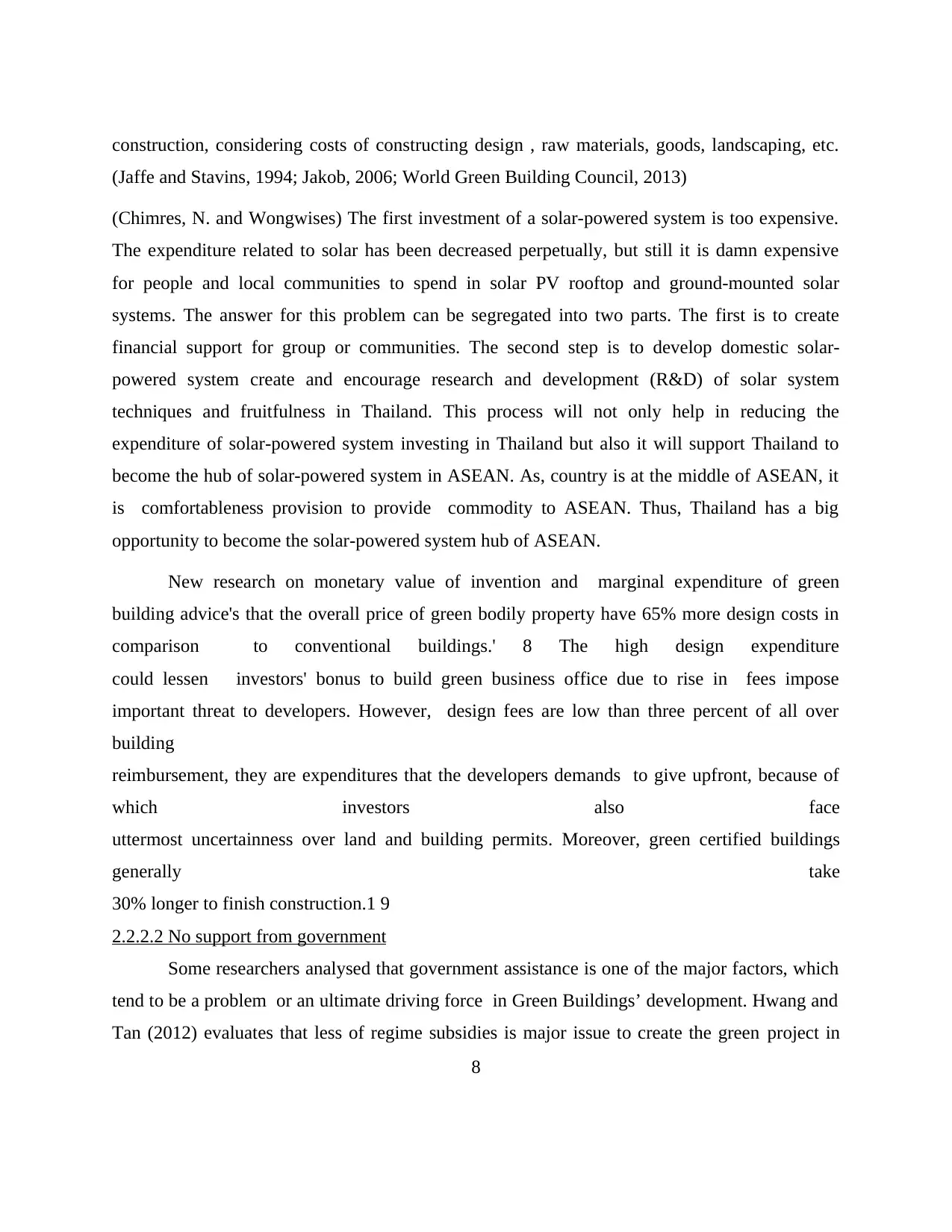
construction, considering costs of constructing design , raw materials, goods, landscaping, etc.
(Jaffe and Stavins, 1994; Jakob, 2006; World Green Building Council, 2013)
(Chimres, N. and Wongwises) The first investment of a solar-powered system is too expensive.
The expenditure related to solar has been decreased perpetually, but still it is damn expensive
for people and local communities to spend in solar PV rooftop and ground-mounted solar
systems. The answer for this problem can be segregated into two parts. The first is to create
financial support for group or communities. The second step is to develop domestic solar-
powered system create and encourage research and development (R&D) of solar system
techniques and fruitfulness in Thailand. This process will not only help in reducing the
expenditure of solar-powered system investing in Thailand but also it will support Thailand to
become the hub of solar-powered system in ASEAN. As, country is at the middle of ASEAN, it
is comfortableness provision to provide commodity to ASEAN. Thus, Thailand has a big
opportunity to become the solar-powered system hub of ASEAN.
New research on monetary value of invention and marginal expenditure of green
building advice's that the overall price of green bodily property have 65% more design costs in
comparison to conventional buildings.' 8 The high design expenditure
could lessen investors' bonus to build green business office due to rise in fees impose
important threat to developers. However, design fees are low than three percent of all over
building
reimbursement, they are expenditures that the developers demands to give upfront, because of
which investors also face
uttermost uncertainness over land and building permits. Moreover, green certified buildings
generally take
30% longer to finish construction.1 9
2.2.2.2 No support from government
Some researchers analysed that government assistance is one of the major factors, which
tend to be a problem or an ultimate driving force in Green Buildings’ development. Hwang and
Tan (2012) evaluates that less of regime subsidies is major issue to create the green project in
8
(Jaffe and Stavins, 1994; Jakob, 2006; World Green Building Council, 2013)
(Chimres, N. and Wongwises) The first investment of a solar-powered system is too expensive.
The expenditure related to solar has been decreased perpetually, but still it is damn expensive
for people and local communities to spend in solar PV rooftop and ground-mounted solar
systems. The answer for this problem can be segregated into two parts. The first is to create
financial support for group or communities. The second step is to develop domestic solar-
powered system create and encourage research and development (R&D) of solar system
techniques and fruitfulness in Thailand. This process will not only help in reducing the
expenditure of solar-powered system investing in Thailand but also it will support Thailand to
become the hub of solar-powered system in ASEAN. As, country is at the middle of ASEAN, it
is comfortableness provision to provide commodity to ASEAN. Thus, Thailand has a big
opportunity to become the solar-powered system hub of ASEAN.
New research on monetary value of invention and marginal expenditure of green
building advice's that the overall price of green bodily property have 65% more design costs in
comparison to conventional buildings.' 8 The high design expenditure
could lessen investors' bonus to build green business office due to rise in fees impose
important threat to developers. However, design fees are low than three percent of all over
building
reimbursement, they are expenditures that the developers demands to give upfront, because of
which investors also face
uttermost uncertainness over land and building permits. Moreover, green certified buildings
generally take
30% longer to finish construction.1 9
2.2.2.2 No support from government
Some researchers analysed that government assistance is one of the major factors, which
tend to be a problem or an ultimate driving force in Green Buildings’ development. Hwang and
Tan (2012) evaluates that less of regime subsidies is major issue to create the green project in
8
Paraphrase This Document
Need a fresh take? Get an instant paraphrase of this document with our AI Paraphraser
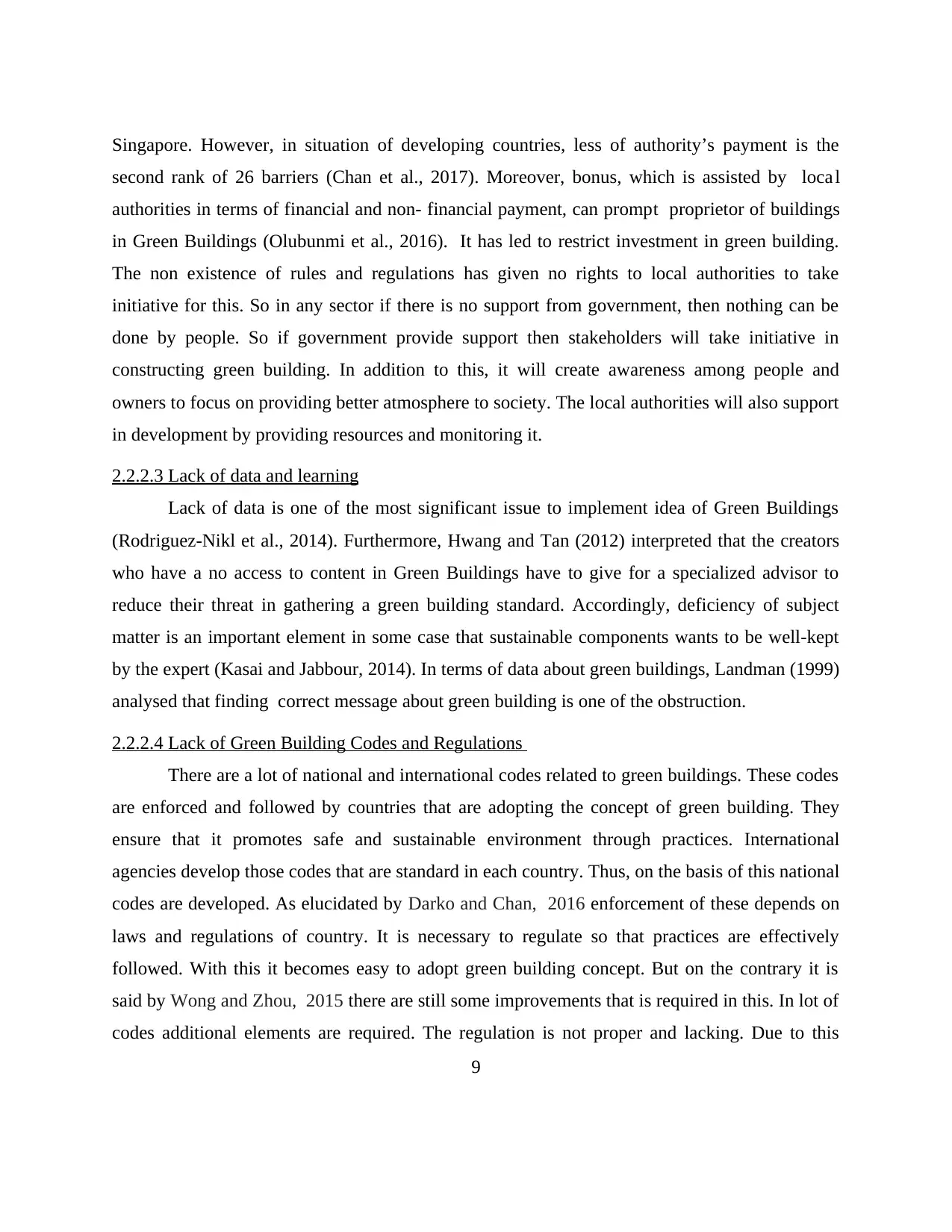
Singapore. However, in situation of developing countries, less of authority’s payment is the
second rank of 26 barriers (Chan et al., 2017). Moreover, bonus, which is assisted by loca l
authorities in terms of financial and non- financial payment, can prompt proprietor of buildings
in Green Buildings (Olubunmi et al., 2016). It has led to restrict investment in green building.
The non existence of rules and regulations has given no rights to local authorities to take
initiative for this. So in any sector if there is no support from government, then nothing can be
done by people. So if government provide support then stakeholders will take initiative in
constructing green building. In addition to this, it will create awareness among people and
owners to focus on providing better atmosphere to society. The local authorities will also support
in development by providing resources and monitoring it.
2.2.2.3 Lack of data and learning
Lack of data is one of the most significant issue to implement idea of Green Buildings
(Rodriguez-Nikl et al., 2014). Furthermore, Hwang and Tan (2012) interpreted that the creators
who have a no access to content in Green Buildings have to give for a specialized advisor to
reduce their threat in gathering a green building standard. Accordingly, deficiency of subject
matter is an important element in some case that sustainable components wants to be well-kept
by the expert (Kasai and Jabbour, 2014). In terms of data about green buildings, Landman (1999)
analysed that finding correct message about green building is one of the obstruction.
2.2.2.4 Lack of Green Building Codes and Regulations
There are a lot of national and international codes related to green buildings. These codes
are enforced and followed by countries that are adopting the concept of green building. They
ensure that it promotes safe and sustainable environment through practices. International
agencies develop those codes that are standard in each country. Thus, on the basis of this national
codes are developed. As elucidated by Darko and Chan, 2016 enforcement of these depends on
laws and regulations of country. It is necessary to regulate so that practices are effectively
followed. With this it becomes easy to adopt green building concept. But on the contrary it is
said by Wong and Zhou, 2015 there are still some improvements that is required in this. In lot of
codes additional elements are required. The regulation is not proper and lacking. Due to this
9
second rank of 26 barriers (Chan et al., 2017). Moreover, bonus, which is assisted by loca l
authorities in terms of financial and non- financial payment, can prompt proprietor of buildings
in Green Buildings (Olubunmi et al., 2016). It has led to restrict investment in green building.
The non existence of rules and regulations has given no rights to local authorities to take
initiative for this. So in any sector if there is no support from government, then nothing can be
done by people. So if government provide support then stakeholders will take initiative in
constructing green building. In addition to this, it will create awareness among people and
owners to focus on providing better atmosphere to society. The local authorities will also support
in development by providing resources and monitoring it.
2.2.2.3 Lack of data and learning
Lack of data is one of the most significant issue to implement idea of Green Buildings
(Rodriguez-Nikl et al., 2014). Furthermore, Hwang and Tan (2012) interpreted that the creators
who have a no access to content in Green Buildings have to give for a specialized advisor to
reduce their threat in gathering a green building standard. Accordingly, deficiency of subject
matter is an important element in some case that sustainable components wants to be well-kept
by the expert (Kasai and Jabbour, 2014). In terms of data about green buildings, Landman (1999)
analysed that finding correct message about green building is one of the obstruction.
2.2.2.4 Lack of Green Building Codes and Regulations
There are a lot of national and international codes related to green buildings. These codes
are enforced and followed by countries that are adopting the concept of green building. They
ensure that it promotes safe and sustainable environment through practices. International
agencies develop those codes that are standard in each country. Thus, on the basis of this national
codes are developed. As elucidated by Darko and Chan, 2016 enforcement of these depends on
laws and regulations of country. It is necessary to regulate so that practices are effectively
followed. With this it becomes easy to adopt green building concept. But on the contrary it is
said by Wong and Zhou, 2015 there are still some improvements that is required in this. In lot of
codes additional elements are required. The regulation is not proper and lacking. Due to this
9
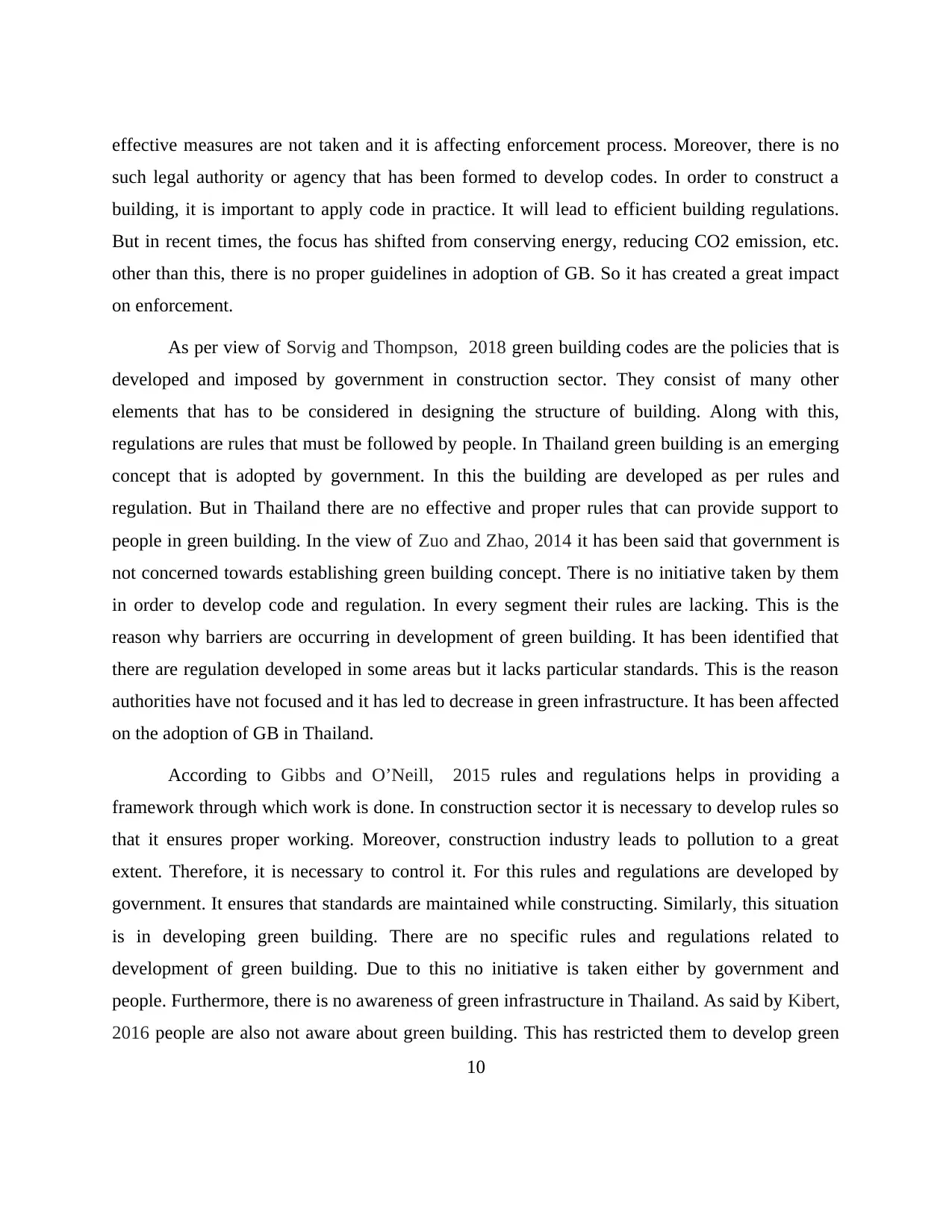
effective measures are not taken and it is affecting enforcement process. Moreover, there is no
such legal authority or agency that has been formed to develop codes. In order to construct a
building, it is important to apply code in practice. It will lead to efficient building regulations.
But in recent times, the focus has shifted from conserving energy, reducing CO2 emission, etc.
other than this, there is no proper guidelines in adoption of GB. So it has created a great impact
on enforcement.
As per view of Sorvig and Thompson, 2018 green building codes are the policies that is
developed and imposed by government in construction sector. They consist of many other
elements that has to be considered in designing the structure of building. Along with this,
regulations are rules that must be followed by people. In Thailand green building is an emerging
concept that is adopted by government. In this the building are developed as per rules and
regulation. But in Thailand there are no effective and proper rules that can provide support to
people in green building. In the view of Zuo and Zhao, 2014 it has been said that government is
not concerned towards establishing green building concept. There is no initiative taken by them
in order to develop code and regulation. In every segment their rules are lacking. This is the
reason why barriers are occurring in development of green building. It has been identified that
there are regulation developed in some areas but it lacks particular standards. This is the reason
authorities have not focused and it has led to decrease in green infrastructure. It has been affected
on the adoption of GB in Thailand.
According to Gibbs and O’Neill, 2015 rules and regulations helps in providing a
framework through which work is done. In construction sector it is necessary to develop rules so
that it ensures proper working. Moreover, construction industry leads to pollution to a great
extent. Therefore, it is necessary to control it. For this rules and regulations are developed by
government. It ensures that standards are maintained while constructing. Similarly, this situation
is in developing green building. There are no specific rules and regulations related to
development of green building. Due to this no initiative is taken either by government and
people. Furthermore, there is no awareness of green infrastructure in Thailand. As said by Kibert,
2016 people are also not aware about green building. This has restricted them to develop green
10
such legal authority or agency that has been formed to develop codes. In order to construct a
building, it is important to apply code in practice. It will lead to efficient building regulations.
But in recent times, the focus has shifted from conserving energy, reducing CO2 emission, etc.
other than this, there is no proper guidelines in adoption of GB. So it has created a great impact
on enforcement.
As per view of Sorvig and Thompson, 2018 green building codes are the policies that is
developed and imposed by government in construction sector. They consist of many other
elements that has to be considered in designing the structure of building. Along with this,
regulations are rules that must be followed by people. In Thailand green building is an emerging
concept that is adopted by government. In this the building are developed as per rules and
regulation. But in Thailand there are no effective and proper rules that can provide support to
people in green building. In the view of Zuo and Zhao, 2014 it has been said that government is
not concerned towards establishing green building concept. There is no initiative taken by them
in order to develop code and regulation. In every segment their rules are lacking. This is the
reason why barriers are occurring in development of green building. It has been identified that
there are regulation developed in some areas but it lacks particular standards. This is the reason
authorities have not focused and it has led to decrease in green infrastructure. It has been affected
on the adoption of GB in Thailand.
According to Gibbs and O’Neill, 2015 rules and regulations helps in providing a
framework through which work is done. In construction sector it is necessary to develop rules so
that it ensures proper working. Moreover, construction industry leads to pollution to a great
extent. Therefore, it is necessary to control it. For this rules and regulations are developed by
government. It ensures that standards are maintained while constructing. Similarly, this situation
is in developing green building. There are no specific rules and regulations related to
development of green building. Due to this no initiative is taken either by government and
people. Furthermore, there is no awareness of green infrastructure in Thailand. As said by Kibert,
2016 people are also not aware about green building. This has restricted them to develop green
10
⊘ This is a preview!⊘
Do you want full access?
Subscribe today to unlock all pages.

Trusted by 1+ million students worldwide
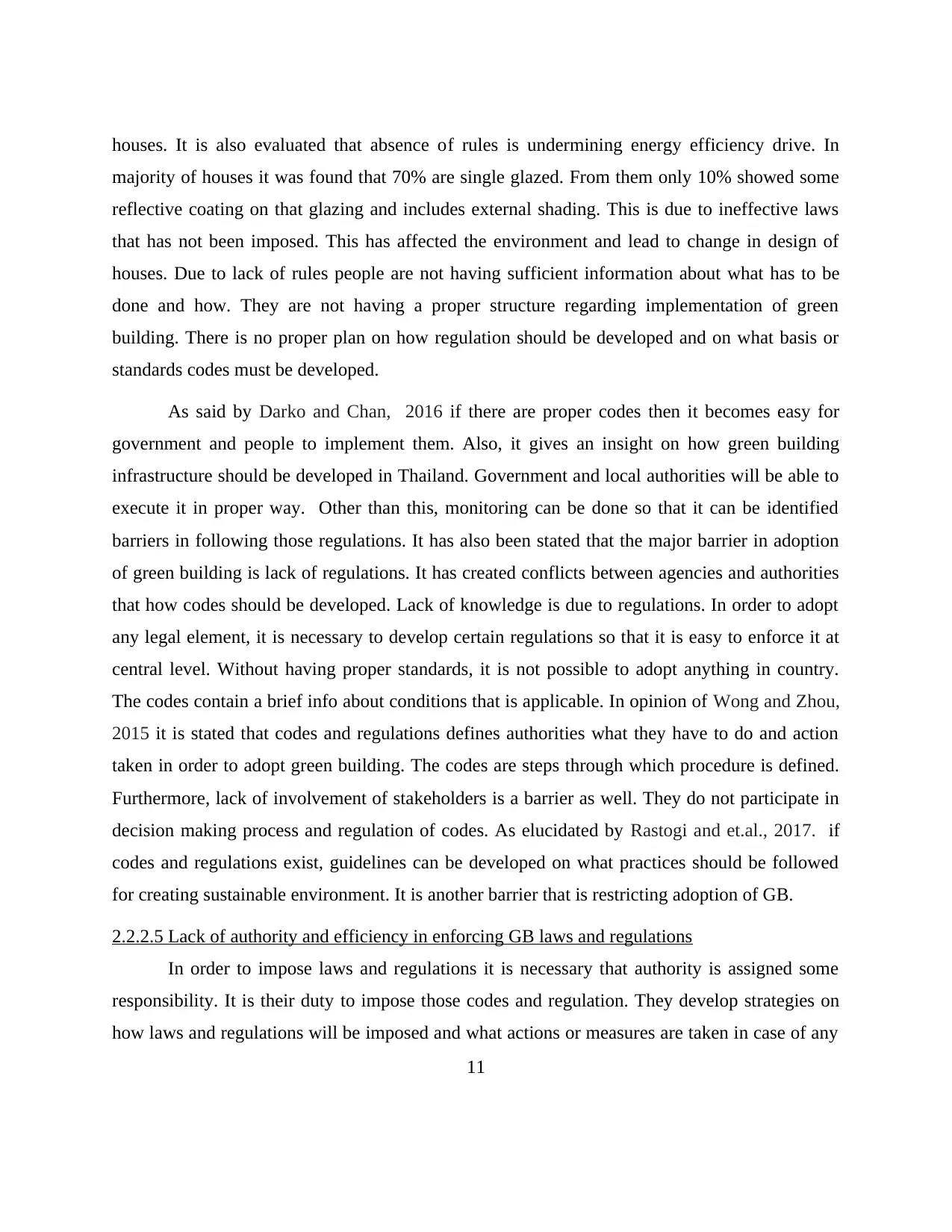
houses. It is also evaluated that absence of rules is undermining energy efficiency drive. In
majority of houses it was found that 70% are single glazed. From them only 10% showed some
reflective coating on that glazing and includes external shading. This is due to ineffective laws
that has not been imposed. This has affected the environment and lead to change in design of
houses. Due to lack of rules people are not having sufficient information about what has to be
done and how. They are not having a proper structure regarding implementation of green
building. There is no proper plan on how regulation should be developed and on what basis or
standards codes must be developed.
As said by Darko and Chan, 2016 if there are proper codes then it becomes easy for
government and people to implement them. Also, it gives an insight on how green building
infrastructure should be developed in Thailand. Government and local authorities will be able to
execute it in proper way. Other than this, monitoring can be done so that it can be identified
barriers in following those regulations. It has also been stated that the major barrier in adoption
of green building is lack of regulations. It has created conflicts between agencies and authorities
that how codes should be developed. Lack of knowledge is due to regulations. In order to adopt
any legal element, it is necessary to develop certain regulations so that it is easy to enforce it at
central level. Without having proper standards, it is not possible to adopt anything in country.
The codes contain a brief info about conditions that is applicable. In opinion of Wong and Zhou,
2015 it is stated that codes and regulations defines authorities what they have to do and action
taken in order to adopt green building. The codes are steps through which procedure is defined.
Furthermore, lack of involvement of stakeholders is a barrier as well. They do not participate in
decision making process and regulation of codes. As elucidated by Rastogi and et.al., 2017. if
codes and regulations exist, guidelines can be developed on what practices should be followed
for creating sustainable environment. It is another barrier that is restricting adoption of GB.
2.2.2.5 Lack of authority and efficiency in enforcing GB laws and regulations
In order to impose laws and regulations it is necessary that authority is assigned some
responsibility. It is their duty to impose those codes and regulation. They develop strategies on
how laws and regulations will be imposed and what actions or measures are taken in case of any
11
majority of houses it was found that 70% are single glazed. From them only 10% showed some
reflective coating on that glazing and includes external shading. This is due to ineffective laws
that has not been imposed. This has affected the environment and lead to change in design of
houses. Due to lack of rules people are not having sufficient information about what has to be
done and how. They are not having a proper structure regarding implementation of green
building. There is no proper plan on how regulation should be developed and on what basis or
standards codes must be developed.
As said by Darko and Chan, 2016 if there are proper codes then it becomes easy for
government and people to implement them. Also, it gives an insight on how green building
infrastructure should be developed in Thailand. Government and local authorities will be able to
execute it in proper way. Other than this, monitoring can be done so that it can be identified
barriers in following those regulations. It has also been stated that the major barrier in adoption
of green building is lack of regulations. It has created conflicts between agencies and authorities
that how codes should be developed. Lack of knowledge is due to regulations. In order to adopt
any legal element, it is necessary to develop certain regulations so that it is easy to enforce it at
central level. Without having proper standards, it is not possible to adopt anything in country.
The codes contain a brief info about conditions that is applicable. In opinion of Wong and Zhou,
2015 it is stated that codes and regulations defines authorities what they have to do and action
taken in order to adopt green building. The codes are steps through which procedure is defined.
Furthermore, lack of involvement of stakeholders is a barrier as well. They do not participate in
decision making process and regulation of codes. As elucidated by Rastogi and et.al., 2017. if
codes and regulations exist, guidelines can be developed on what practices should be followed
for creating sustainable environment. It is another barrier that is restricting adoption of GB.
2.2.2.5 Lack of authority and efficiency in enforcing GB laws and regulations
In order to impose laws and regulations it is necessary that authority is assigned some
responsibility. It is their duty to impose those codes and regulation. They develop strategies on
how laws and regulations will be imposed and what actions or measures are taken in case of any
11
Paraphrase This Document
Need a fresh take? Get an instant paraphrase of this document with our AI Paraphraser
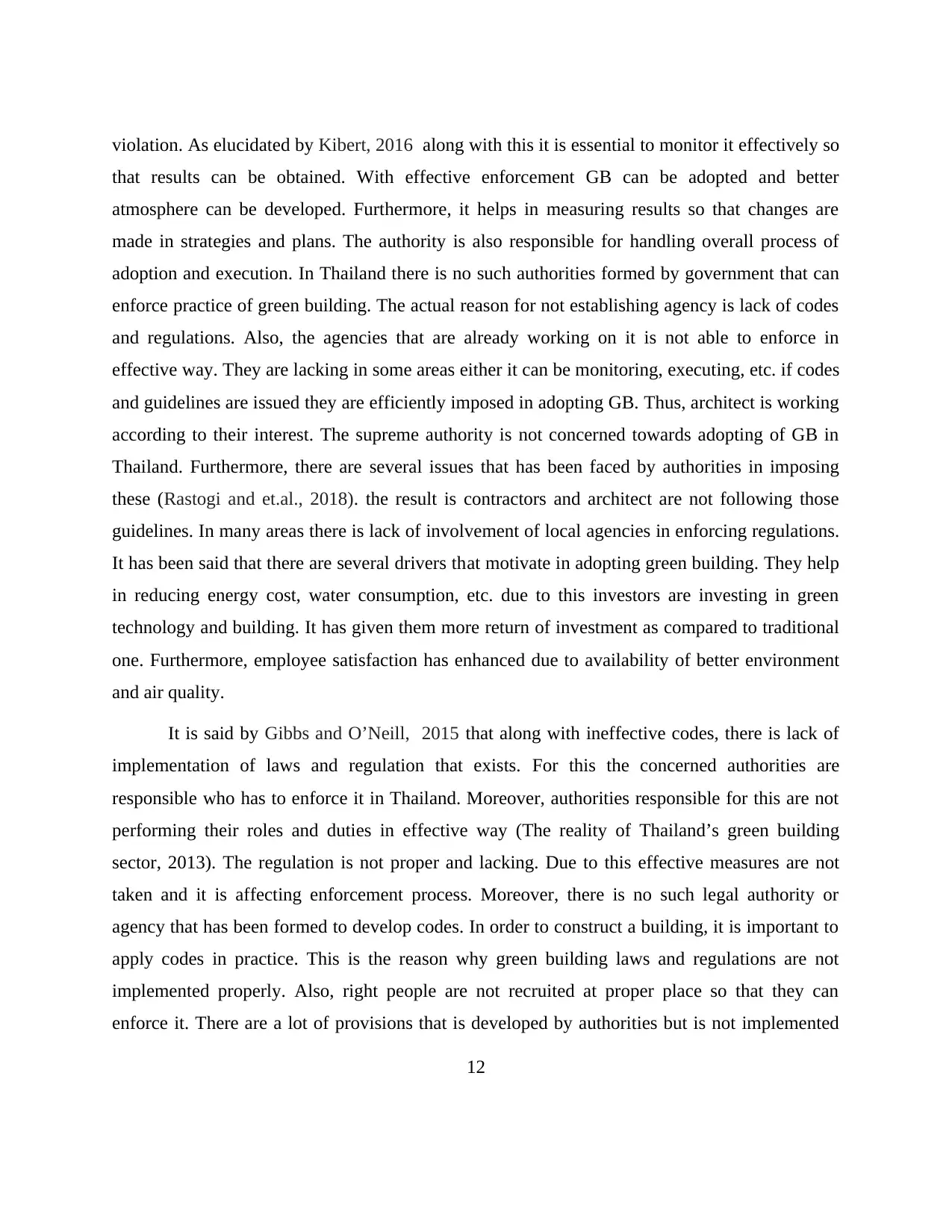
violation. As elucidated by Kibert, 2016 along with this it is essential to monitor it effectively so
that results can be obtained. With effective enforcement GB can be adopted and better
atmosphere can be developed. Furthermore, it helps in measuring results so that changes are
made in strategies and plans. The authority is also responsible for handling overall process of
adoption and execution. In Thailand there is no such authorities formed by government that can
enforce practice of green building. The actual reason for not establishing agency is lack of codes
and regulations. Also, the agencies that are already working on it is not able to enforce in
effective way. They are lacking in some areas either it can be monitoring, executing, etc. if codes
and guidelines are issued they are efficiently imposed in adopting GB. Thus, architect is working
according to their interest. The supreme authority is not concerned towards adopting of GB in
Thailand. Furthermore, there are several issues that has been faced by authorities in imposing
these (Rastogi and et.al., 2018). the result is contractors and architect are not following those
guidelines. In many areas there is lack of involvement of local agencies in enforcing regulations.
It has been said that there are several drivers that motivate in adopting green building. They help
in reducing energy cost, water consumption, etc. due to this investors are investing in green
technology and building. It has given them more return of investment as compared to traditional
one. Furthermore, employee satisfaction has enhanced due to availability of better environment
and air quality.
It is said by Gibbs and O’Neill, 2015 that along with ineffective codes, there is lack of
implementation of laws and regulation that exists. For this the concerned authorities are
responsible who has to enforce it in Thailand. Moreover, authorities responsible for this are not
performing their roles and duties in effective way (The reality of Thailand’s green building
sector, 2013). The regulation is not proper and lacking. Due to this effective measures are not
taken and it is affecting enforcement process. Moreover, there is no such legal authority or
agency that has been formed to develop codes. In order to construct a building, it is important to
apply codes in practice. This is the reason why green building laws and regulations are not
implemented properly. Also, right people are not recruited at proper place so that they can
enforce it. There are a lot of provisions that is developed by authorities but is not implemented
12
that results can be obtained. With effective enforcement GB can be adopted and better
atmosphere can be developed. Furthermore, it helps in measuring results so that changes are
made in strategies and plans. The authority is also responsible for handling overall process of
adoption and execution. In Thailand there is no such authorities formed by government that can
enforce practice of green building. The actual reason for not establishing agency is lack of codes
and regulations. Also, the agencies that are already working on it is not able to enforce in
effective way. They are lacking in some areas either it can be monitoring, executing, etc. if codes
and guidelines are issued they are efficiently imposed in adopting GB. Thus, architect is working
according to their interest. The supreme authority is not concerned towards adopting of GB in
Thailand. Furthermore, there are several issues that has been faced by authorities in imposing
these (Rastogi and et.al., 2018). the result is contractors and architect are not following those
guidelines. In many areas there is lack of involvement of local agencies in enforcing regulations.
It has been said that there are several drivers that motivate in adopting green building. They help
in reducing energy cost, water consumption, etc. due to this investors are investing in green
technology and building. It has given them more return of investment as compared to traditional
one. Furthermore, employee satisfaction has enhanced due to availability of better environment
and air quality.
It is said by Gibbs and O’Neill, 2015 that along with ineffective codes, there is lack of
implementation of laws and regulation that exists. For this the concerned authorities are
responsible who has to enforce it in Thailand. Moreover, authorities responsible for this are not
performing their roles and duties in effective way (The reality of Thailand’s green building
sector, 2013). The regulation is not proper and lacking. Due to this effective measures are not
taken and it is affecting enforcement process. Moreover, there is no such legal authority or
agency that has been formed to develop codes. In order to construct a building, it is important to
apply codes in practice. This is the reason why green building laws and regulations are not
implemented properly. Also, right people are not recruited at proper place so that they can
enforce it. There are a lot of provisions that is developed by authorities but is not implemented
12
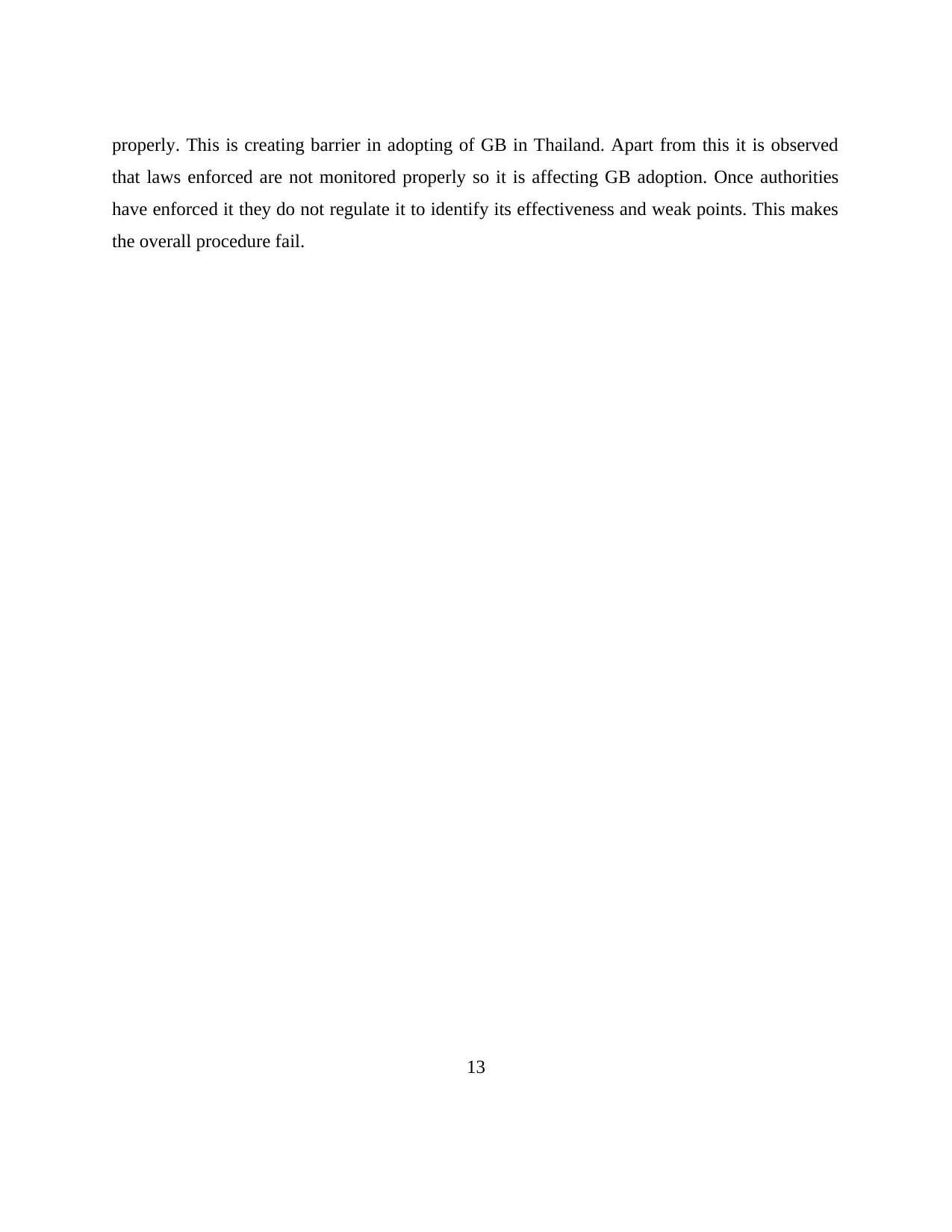
properly. This is creating barrier in adopting of GB in Thailand. Apart from this it is observed
that laws enforced are not monitored properly so it is affecting GB adoption. Once authorities
have enforced it they do not regulate it to identify its effectiveness and weak points. This makes
the overall procedure fail.
13
that laws enforced are not monitored properly so it is affecting GB adoption. Once authorities
have enforced it they do not regulate it to identify its effectiveness and weak points. This makes
the overall procedure fail.
13
⊘ This is a preview!⊘
Do you want full access?
Subscribe today to unlock all pages.

Trusted by 1+ million students worldwide
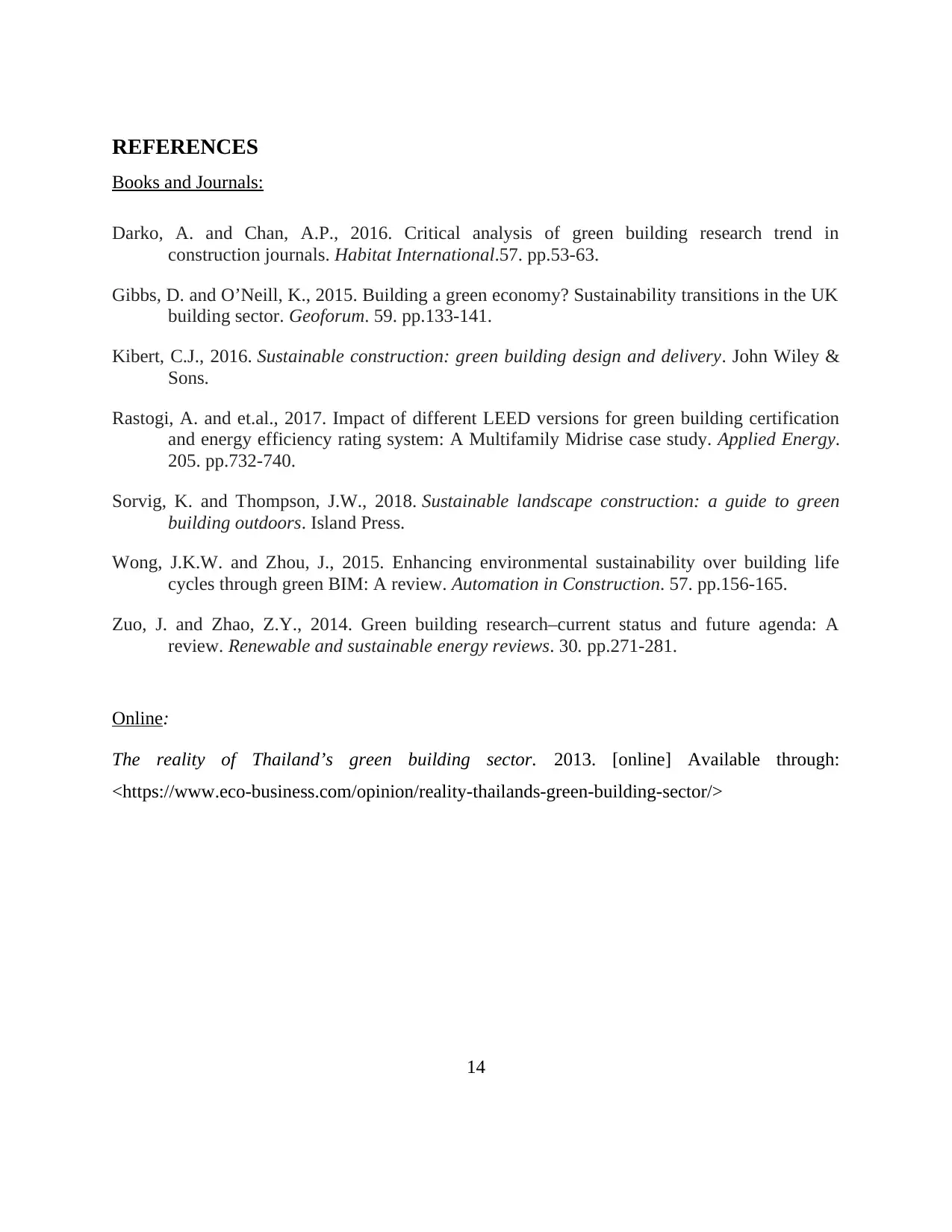
REFERENCES
Books and Journals:
Darko, A. and Chan, A.P., 2016. Critical analysis of green building research trend in
construction journals. Habitat International.57. pp.53-63.
Gibbs, D. and O’Neill, K., 2015. Building a green economy? Sustainability transitions in the UK
building sector. Geoforum. 59. pp.133-141.
Kibert, C.J., 2016. Sustainable construction: green building design and delivery. John Wiley &
Sons.
Rastogi, A. and et.al., 2017. Impact of different LEED versions for green building certification
and energy efficiency rating system: A Multifamily Midrise case study. Applied Energy.
205. pp.732-740.
Sorvig, K. and Thompson, J.W., 2018. Sustainable landscape construction: a guide to green
building outdoors. Island Press.
Wong, J.K.W. and Zhou, J., 2015. Enhancing environmental sustainability over building life
cycles through green BIM: A review. Automation in Construction. 57. pp.156-165.
Zuo, J. and Zhao, Z.Y., 2014. Green building research–current status and future agenda: A
review. Renewable and sustainable energy reviews. 30. pp.271-281.
Online:
The reality of Thailand’s green building sector. 2013. [online] Available through:
<https://www.eco-business.com/opinion/reality-thailands-green-building-sector/>
14
Books and Journals:
Darko, A. and Chan, A.P., 2016. Critical analysis of green building research trend in
construction journals. Habitat International.57. pp.53-63.
Gibbs, D. and O’Neill, K., 2015. Building a green economy? Sustainability transitions in the UK
building sector. Geoforum. 59. pp.133-141.
Kibert, C.J., 2016. Sustainable construction: green building design and delivery. John Wiley &
Sons.
Rastogi, A. and et.al., 2017. Impact of different LEED versions for green building certification
and energy efficiency rating system: A Multifamily Midrise case study. Applied Energy.
205. pp.732-740.
Sorvig, K. and Thompson, J.W., 2018. Sustainable landscape construction: a guide to green
building outdoors. Island Press.
Wong, J.K.W. and Zhou, J., 2015. Enhancing environmental sustainability over building life
cycles through green BIM: A review. Automation in Construction. 57. pp.156-165.
Zuo, J. and Zhao, Z.Y., 2014. Green building research–current status and future agenda: A
review. Renewable and sustainable energy reviews. 30. pp.271-281.
Online:
The reality of Thailand’s green building sector. 2013. [online] Available through:
<https://www.eco-business.com/opinion/reality-thailands-green-building-sector/>
14
1 out of 16
Related Documents
Your All-in-One AI-Powered Toolkit for Academic Success.
+13062052269
info@desklib.com
Available 24*7 on WhatsApp / Email
![[object Object]](/_next/static/media/star-bottom.7253800d.svg)
Unlock your academic potential
© 2024 | Zucol Services PVT LTD | All rights reserved.





